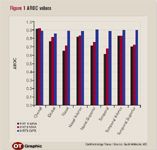Article
New HRT software maintains excellent discriminatory performance in study
Pittsburgh-The Glaucoma Probability Score (GPS), the new mathematical model featured in the Heidelberg Retina Tomograph 3 (HRT3, Heidelberg Engineering) software, eliminates subjective operator input in defining the optic disc margin and performs comparably to the HRT II in discriminating between healthy and glaucomatous eyes, according to a study undertaken by researchers at the University of Pittsburgh.

HRT3 offers several improvements over the previous iterations of HRT: the normative database in HRT3 is larger and ethnicity-specific, and the GPS analysis, which is a neural network technique, generates structural measurements of the optic disc without the need of subjective definition of the disc margin.
To investigate the performance of the HRT3 software, the investigators scanned 50 eyes of 50 patients with glaucoma and 71 eyes of 71 healthy individuals using the HRT II. The contour line at the disc margin was drawn and images were analyzed on the HRT II and then exported for re-analysis to the HRT3 without manipulating the contour line. Discriminatory performance of the various outputs of HRT II and HRT3 were determined by computing the areas under the receiver operating characteristic curve (AROC).
"The need to draw a contour line with the HRT II both is time-consuming and introduces variability between operators. HRT3 offers an important benefit in eliminating that task, and our study suggests clinicians can take advantage of that feature and expect similar discriminatory performance," said Gadi Wollstein, MD, assistant professor of ophthalmology and director of the Ophthalmic Imaging Research Laboratories, University of Pittsburgh School of Medicine. "However, users should be aware that the findings from MRA and GPS analysis should not be considered interchangeable because our studies also show that an eye labeled as normal by one program might be diagnosed as glaucomatous with the other."
Analysis of the outputs for the HRT3 stereometric parameters [linear cup/disc ratio, cup shape measure, rim area, rim volume, mean retinal nerve fiber layer (RNFL) thickness, and height variation contour] showed the linear cup/disc ratio performed best in discriminating between healthy and glaucomatous eyes. It had an AROC value of 0.897 compared with AROC values in the range of 0.615 to 0.871 for the other parameters. Using GPS, horizontal RNFL curvature was the best-discriminating parameter with an AROC value of 0.905. AROC values for the other GPS parameters (GPS global, cup size, vertical RNFL curvature, rim steepness, and cup depth) ranged from 0.560 to 0.899. No significant difference existed between the AROC values for the best discriminators for each method: the linear cup/disc ratio and the horizontal RNFL curvature.
Categorical classifications
Further analyses considered the HRT3 categorical classifications (within normal limits, borderline, and outside normal limits). Comparisons of the HRT3 categorical and continuous stereometric parameters showed a number of statistically significant differences.
"Although these categorical classifications are helpful for giving clinicians some idea about whether an eye is abnormal, we can assume that the ability of this software to discriminate between eyes based on only those three categories would be less than when using the continuous parameters. Clinicians should therefore be aware this categorization scheme might lower their ability to detect disease," Dr. Wollstein said.
He added that the performance of the categorization feature might be improved through further software refinements.
Newsletter
Don’t miss out—get Ophthalmology Times updates on the latest clinical advancements and expert interviews, straight to your inbox.





